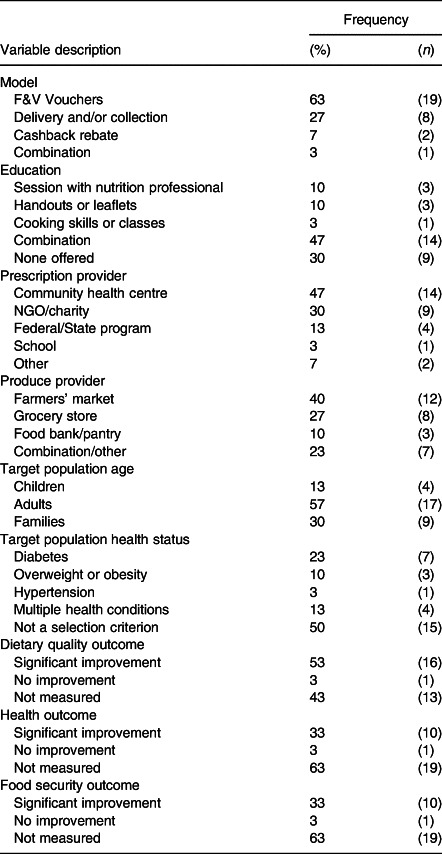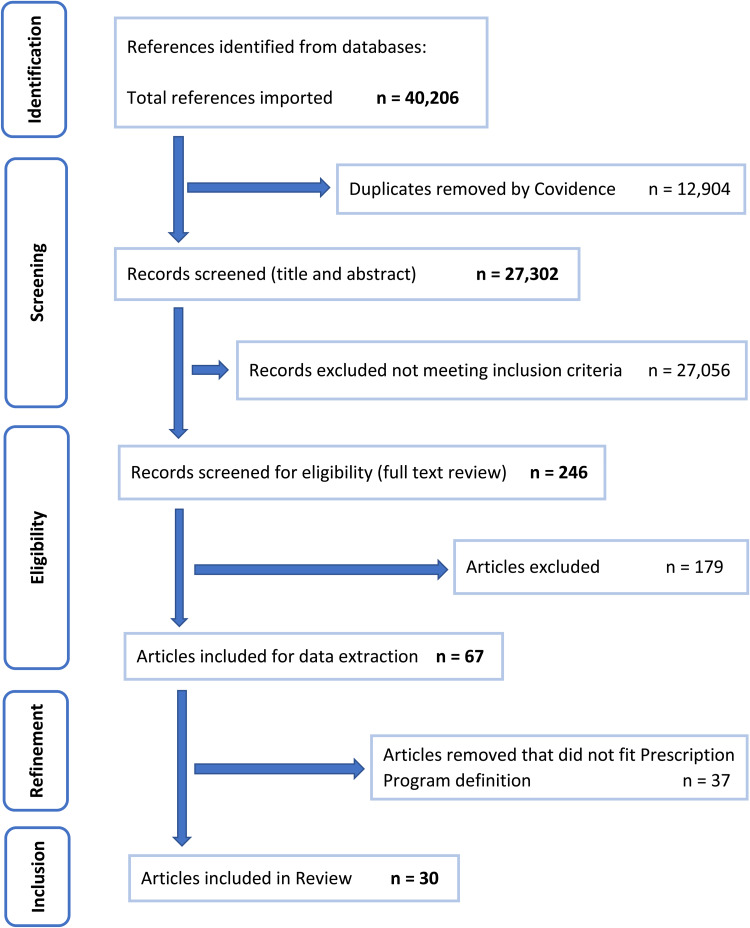基于社区的水果和蔬菜处方计划:范围界定综述。
IF 2.4
Q3 NUTRITION & DIETETICS
Journal of Nutritional Science
Pub Date : 2023-09-15
eCollection Date: 2023-01-01
DOI:10.1017/jns.2023.81
引用次数: 0
摘要
识别和分类基于社区的水果和蔬菜处方计划的不同模型,以确定方法、目标人群特征和测量结果方面的差异。应用范围界定审查方法,利用十个电子数据库来确定基于社区的水果和蔬菜激励计划。结果由两名独立评审员使用Covidence软件进行评估。使用PRISMA ScR指南完成并记录了所有全文审查。搜索结果存储在Covidence软件中并进行审查。在搜索中发现的40206篇文章中,共使用了30篇全文文章。目标人群主要是女性、非白人和低收入人群。研究设计和质量都存在相当大的异质性。63%(n 19)的研究使用了水果和蔬菜券。处方主要由社区卫生中心(47%;n 14)或非政府组织(307%;n 9)提供,可以在农贸市场(40%;n 12)或杂货店(27%;n 8)兑换。经测量,94%(n 16)的研究饮食质量显著改善,83%(n 10)的研究健康状况显著改善,82%(n 10。提供财政激励以抵消新鲜水果和蔬菜的成本可以增加消费,改善健康状况,改善粮食安全状况。大多数研究表明,至少有一项结果有显著改善,证明了基于社区的水果和蔬菜处方计划的有效性。然而,测量技术的多样性以及设计、剂量和持续时间的异质性阻碍了有意义的比较。有必要进行进一步精心设计的研究,以比较不同项目方法之间的影响程度。本文章由计算机程序翻译,如有差异,请以英文原文为准。



Community-based fruit and vegetable prescription programs: a scoping review.
Abstract Identify and categorise different models of community-based fruit and vegetable prescription programs, to determine variation in terms of methodology, target population characteristics, and outcomes measured. Applying the scoping review methodology, ten electronic databases were utilised to identify community-based fruit and vegetable incentive programs. Results were evaluated by two independent reviewers, using Covidence software. All full-text reviews were completed and documented using the PRISMA-ScR guidelines. Search results were stored and reviewed within the Covidence software. Thirty full-text articles were utilised from the 40 206 identified in the search. Target populations were predominantly female, non-white, and low-income. Considerable heterogeneity was found in both study design and quality. Fruit and vegetable vouchers were utilised in 63 % (n 19) of the studies. Prescriptions were primarily provided by community health centres (47 %; n 14) or NGOs (307 %; n 9) and could be redeemed at farmers’ markets (40 %; n 12) or grocery stores (27 %; n 8). When measured, diet quality significantly improved in 94 % (n 16), health outcomes significantly improved in 83 % (n 10), and food security status improved in 82 % (n 10) of studies. Providing financial incentives to offset the cost of fresh fruits and vegetables can increase consumption, improve health outcomes, and improve food security status. The majority of studies showed significant improvements in at least one outcome, demonstrating the effectiveness of community-based fruit and vegetable prescription programs. However, the diversity of measurement techniques and heterogeneity of design, dosage, and duration impeded meaningful comparisons. Further well-designed studies are warranted to compare the magnitude of effects among different program methodologies.
求助全文
通过发布文献求助,成功后即可免费获取论文全文。
去求助
来源期刊

Journal of Nutritional Science
NUTRITION & DIETETICS-
CiteScore
3.00
自引率
0.00%
发文量
91
审稿时长
7 weeks
期刊介绍:
Journal of Nutritional Science is an international, peer-reviewed, online only, open access journal that welcomes high-quality research articles in all aspects of nutrition. The underlying aim of all work should be, as far as possible, to develop nutritional concepts. JNS encompasses the full spectrum of nutritional science including public health nutrition, epidemiology, dietary surveys, nutritional requirements, metabolic studies, body composition, energetics, appetite, obesity, ageing, endocrinology, immunology, neuroscience, microbiology, genetics, molecular and cellular biology and nutrigenomics. JNS welcomes Primary Research Papers, Brief Reports, Review Articles, Systematic Reviews, Workshop Reports, Letters to the Editor and Obituaries.
 求助内容:
求助内容: 应助结果提醒方式:
应助结果提醒方式:


